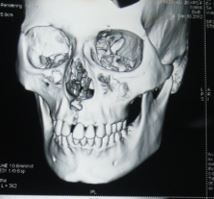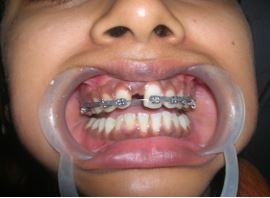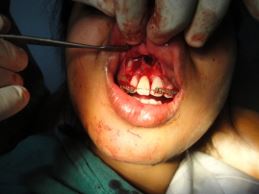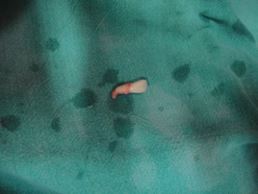Biography
Interests
Chandresh Jaiswara
Department of Oral and Maxillofacial Surgery, Institute of Medical Sciences BHU, India
*Correspondence to: Dr. Chandresh Jaiswara, Department of Oral and Maxillofacial Surgery, Institute of Medical Sciences BHU, India.
Copyright © 2018 Dr. Chandresh Jaiswara. This is an open access article distributed under the Creative Commons Attribution License, which permits unrestricted use, distribution, and reproduction in any medium, provided the original work is properly cited.
Introduction
Facial aesthetics is always a prime concern for a young patients and teen age in the current population
in developed and developing country like india. Any deficiency in anterior tooth anomaly may create
anxiety and depression. This anxiety and depression may hamper patients personal and married life and
overall personality. The case report reported here reveals an interrupted right central incisor situated on a
ectopic position creating spacing in maxillary anterior region & gives an un-aesthetic facial appearance.
Auto-transplantation is a method of choice for a strange or ectopic positioned impacted anterior tooth
on appropriate site offers a new treatment option for some clinical situation if orthodontics approach
is not possible to correct the tooth position. Auto-transplantation permits tooth movement to distance
or opposite sides of the same dental arch as well as to opposite jaw. This procedure also offers potential
benefits of reestablishment of normal alveolar process development, aesthetics, functions and arch integrity.
This procedure has a potential to become a viable alternative treatment plan for a young patients with low
socioeconomic status allowing the reestablishment of restoration of missing teeth & its functions. This
article discusses method of auto-reimplantation of a tooth in freshly surgically prepared socket, biological
principle, and establishment of functions, aesthetics, and phonetics.
Review of Literature
Auto-transplantation pertaining to the repositioning of Autogenous erupted, semi-erupted or unerupted
tooth; from one site into another in the same individual [1]. The earliest reports of tooth transplantation involve slaves in ancient Egypt who were forced to give their
teeth to their pharaohs [2]. Transplantation site may be either an extraction site or newly surgically prepared
alveolus to receive a tooth [3,4]. Transplantation plays a key role in restoration of functions of missing tooth.
Autogenic transplantation was first described by Swedish dental surgeon Vidman in 1915 [2]. Transplantation
offers a new horizon for bone induction and reestablishment of a normal alveolar process in addition to tooth
replacement and restoration of aesthetics and functions, arch integrity and phonetics. If transplant fails,
there will be an intact site to receive the implant. A prerequisite for this method is a thorough knowledge
of factors influencing the success rate (biological principle). Autogenous tooth transplantation was first
well documented in 1954 by M.L. Hale. The major principles of his technique are still followed today [5].
Atypical tooth eruption can also be an indication for auto-transplantation. Ectopically positioned teeth are
usually exposed surgically and then orthodontic treatment is applied. In cases of severe ectopic position of
maxillary canines (ectopic canines present about 2% of population) [6] Several research highlight how autotransplantation
of teeth can be considered as successful as endosseous dental implant positioning [2,7-9].
Case Report
A 25 year young lady came to the dental OPD IMS, BHU with complain of nonerupting right central
incisor. She had no significant medical history. Intraoral examination revealed normal teeth with narrow
3.5mm space for right central incisors due to unerupted right central incisor. On radiographic evaluation an
impacted central incisor was noted. To know the exact position of impacted tooth a CT scan was advised.
CT scan showed a strange position of impacted tooth (Fig-1). Orthodontist was consulted and He had
denied for repositioning of central incisor on their appropriate space by means of orthodontic movement
probably due to far distant position of the tooth with their curved roots and possibility of damage to the
nasal floor and antrum.

Treatment Plan
Right central incisor space was recreated by means of orthodontic movement (Fig-2). After acquiring
adequate space for right central incisor we planned for surgical repositioning or auto-transplantation of impacted central incisor into a surgically, freshly prepared socket After surgical part preparation with
betadine solution an incision was made from distal surface of right lateral incisor to the distal surface of left
maxillary central incisor. The flap was raised with the help of periosteal elevator by considering the normal
anatomical structure. Raised flap exposes the crown of central incisors which was positioned anterio-lateral
direction and root tip was near the nasal antrum as noted in CT scan.

A small groove was made around the neck of impacted central incisor with the help of small bone cutting rotary bur with adequate cooling for a better forceps grip. A gradual small rotary force was applied on neck of the impacted tooth to prevent fracture of tooth neck or root. This technique helps us to expand the alveolar bone and tooth was removed and placed in sterile normal saline.
Socket Preparation
Tooth socket was prepared with the help of bone cutting surgical bur with adequate cooling system to prevent
minimal changes in bone physiology. This step helps in better post operative healing. Since bony socket was
freshly prepared so there is no periodontal ligament required for tooth attachment but we facilitate for
ankylosis. Diameter of tooth root was measured and a adequate root angulations was obtained. (Fig.-3).

Tooth Preparation
a) Root surface preparation: Root was fully formed (Fig.-4). Since, we promotes ankylosis therefore
periodontal ligaments are non significant. Therefore ligaments are scraped off from the root surface and root
was treated with sodium fluoride 2% for five (or 20 minutes) minutes and washed with normal saline to
reduce the rate of root resorption.
b) Endodontic treatment: since root apex was fully formed and we have decided to do the RCT and
orthograde obturation was done extra orally and sealed the canal with GIC cements.

Placement of extracted impacted tooth into freshly prepared bony socket: extracted tooth was transplanted into prepared socket gently. Precaution was taken to stimulate bleeding into the socket to receive the transplanted tooth and disoccludes the transplanted tooth from occlusion to promote healing.
Discussion
Aesthetics is a prime concern for a young lady. Any deficiency in anterior tooth anomaly may create anxiety
and depression. This anxiety and depression may hamper her married life and overall personality. In above
case lady was unmarried post graduate and very much worry about her personality, looks and upcoming
married life, & behaviour of colleague. Type of healing of transplanted tooth is dependent on the surface
area of the damaged root to be repopulated. If damaged PDL is small, the healing would be achieved
by cemental healing. If damaged PDL surface is large, some of root surface will be resorbed followed by
apposition of bone (Ankylosis). Thus root resorption will ensure. The contributions of progenitors PDL
cells on the recipient freshly extraction sockets also accounts for the higher success rate for freshly extracted
recipient sockets as compared to artificially drilled one [10,11].
Conclusion
Auto transplantation of strange positioned impacted central incisor on an appropriate site offers a new
treatment option for some clinical situation. It permits tooth movement to distance or opposite sides of the
same dental arch as well as to opposite jaw. This procedure also offers potential benefits of reestablishment of
normal alveolar process development, aesthetics, functions and arch integrity. This procedure has a potential
to become a viable alternative treatment plan for a young patients with low socioeconomic status allowing
the reestablishment of restoration of missing teeth & its functions.
Bibliography

Hi!
We're here to answer your questions!
Send us a message via Whatsapp, and we'll reply the moment we're available!